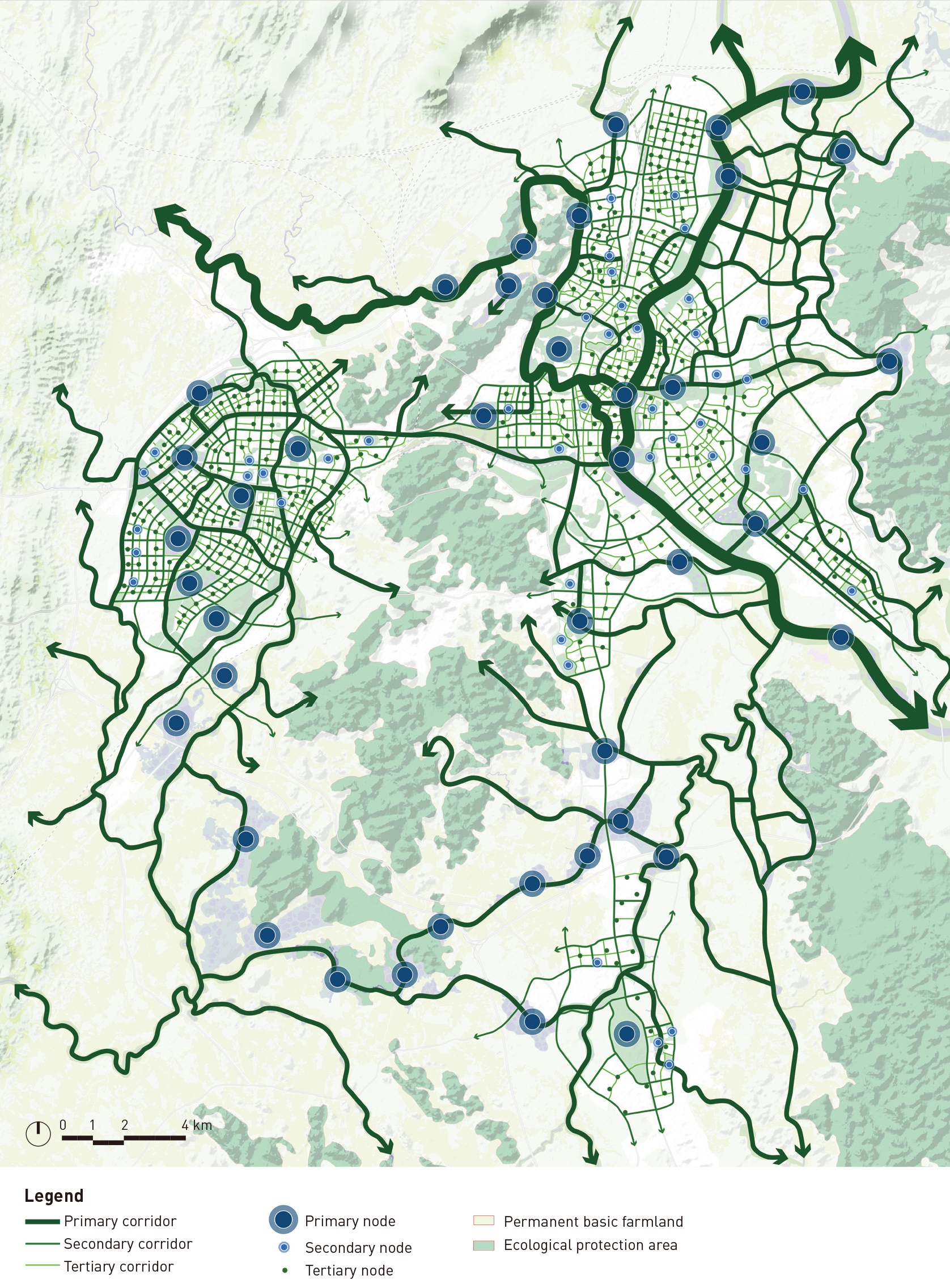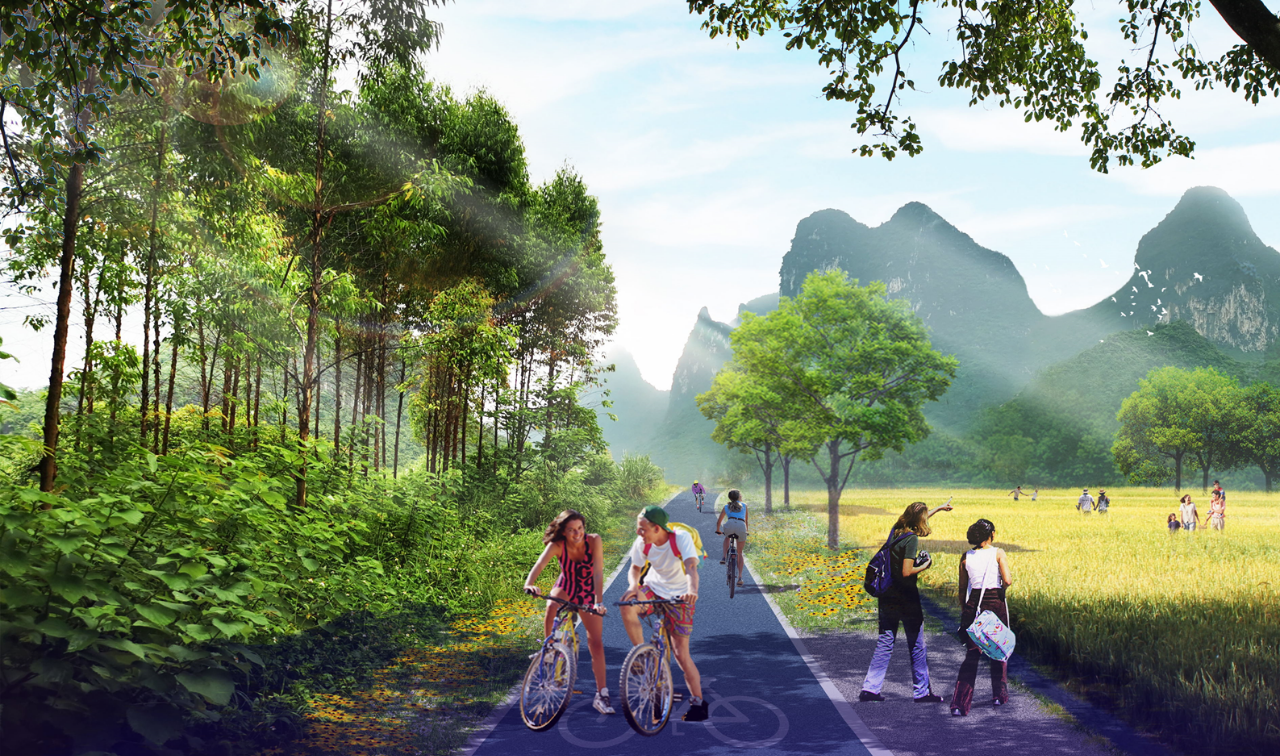
地址:北京市海淀區中關村北大街100號(北樓)北京大學建筑與景觀設計學院一層 Email:info@landscape.cn
Copyright ? 2013-2022 景觀中國(www.36byz.com)版權所有 京ICP備05068035號
 京公海網安備 110108000058號
京公海網安備 110108000058號

? 土人設計
中國眾多地區都擁有得天獨厚的自然與文化資產和氣候條件,具備成為世界級的旅居目的地的潛力。但長期以來,當地單一的觀光旅游開發模式、粗暴的基礎設施建設方式和粗放的土地開發模式,使大量不可再生的自然景觀和鄉土文化景觀遭到破壞。筆者認為,隨著人民對美好生活的需求和審美品位不斷提高,旅居生活將成為未來社會的重要產品需求。在新的基礎設施建設高潮來臨之際,中國廣大具有獨特自然和文化景觀的區域,有必要規劃和建設面向未來的世界級旅居目的地的新型基礎設施,并有必要盡快制定相應的鄉村土地利用策略。本文介紹了筆者向桂林市政府提出的“成就世界級旅游城市的三項建議”,旨在呼吁相關決策者抓住即將到來的基礎設施建設和正在進行的鄉村振興的機遇,構建面向未來、作為世界級旅居目的地的新型基礎設施。這三項建議也同樣可為其他具有成為世界級旅居目的地潛力的區域決策者提供參考。
俞孔堅
北京大學建筑與景觀設計學院教授
原文刊發時間:2022年5月
廣西桂林、安徽黃山、江西婺源、四川涼山、云南大理、貴州興義、新疆吐魯番、海南島全境、西藏全境等地,都擁有堪稱得天獨厚的自然與文化資產和氣候條件,完全可以成為世界級的旅居目的地。但長期以來,當地單一的觀光旅游開發模式使這類優質資產得不到應有的價值體現;同時,粗暴的基礎設施建設方式(包括大規模的鄉村拆遷和工業化的鄉村水利工程等)和粗放的土地開發模式,使大量不可再生的自然景觀和鄉土文化景觀遭到破壞。隨著城市化水平的提高,人民對美好生活的需求和審美品位不斷提高,旅居生活將成為未來社會的重要產品需求,而那些看似尋常的鄉土文化景觀資產將成為稀缺資源。
2022年4月,中央財經委員會第十一次會議召開,研究全面加強基礎設施建設問題。在新的基礎設施建設高潮來臨之際,中國廣大具有獨特自然和文化景觀的區域,有必要規劃和建設面向未來的世界級旅居目的地的新型基礎設施,并有必要盡快制定相應的鄉村土地利用策略,避免更多的桃花源消失在黎明之前。在同一時間,桂林市召開“2022年漓江論壇”,筆者向桂林市政府提出“成就世界級旅游城市的三項建議”,旨在呼吁相關決策者抓住即將到來的基礎設施建設和正在進行的鄉村振興的機遇,構建面向未來、作為世界級旅居目的地的新型基礎設施,并制定新型鄉村土地利用策略。
桂林打造世界級旅游城市的行動面臨重大挑戰——既要保護綠水青山,又要成為金山銀山。唯一的途徑是提升桂林山水這一世界級魅力景觀的生態系統服務,將低質量的觀光旅游轉型為高品質的世界級旅居生活產業。這意味著需要構建一種服務于高品質旅居生活的新型基礎設施——生態基礎設施、慢行基礎設施,以及促進鄉村活化、滿足浸入式旅居生活方式的土地利用機制。為此,筆者提出以下三項關鍵措施和建議。
第一項建議,構建魅力景觀網絡。為兌現桂林山水景觀的巨大生態系統服務價值,這一魅力景觀網絡需從宏觀、中觀、微觀三個尺度構建,形成“一心兩環”格局:“一心”為桂林城區,“兩環”分別是南部的“山水旅居環”和北部的“鄉土遺產環”,漓江就是這“一心兩環”之間的紐帶。同時,這一魅力景觀網絡可通過以下四類國土保護和修復措施來實現。
1)國土海綿化。以流域為單位構建水韌性國土,利用基于自然的解決方案調節旱澇:源頭滯蓄雨水,徑流過程減速消能,末端建立適應性景觀,使國土得以滋潤,萬物生機勃勃。
2)水系去硬化。河道渠化硬化是桂林山水景觀的大敵,鋼筋水泥修筑的防洪堤壩使水生態系統和山水景觀的價值都遭受了毀滅性損害。
3)田園有機化。對具有獨特魅力的鄉村地區而言,綠色有機產品生產所能帶來的綜合生態系統服務價值遠遠高于工業化量產的大宗農產品,尤其是就田園景觀的審美啟智服務而言。即使不能在全國范圍內實現生態和綠色農業,至少桂林等少數魅力景觀區域具有推行試點項目的潛力。
4)鄉村遺產保護和活化。過去幾十年間,大量傳統村落被拆遷,可謂一去不復還;同時,殘存的村落也面臨大面積凋敝。然而,被動保護只能使凋敝加速,唯一的出路在于活化利用——在保護鄉村遺產原真性的同時,基于可逆、可辨識的原則,活化利用鄉村遺產,使其成為魅力景觀的一部分。
第二項建議,游在畫中——浸入式體驗,構建慢行網絡,實現自由行旅。經過一年的研究,我們構想了一個覆蓋桂林全域、以“三橫三縱一環”為骨架的綠道網絡,為全域自由行旅提供慢行系統,包括自行車道、水上游覽系統、步道、馬道,以及一條小火車專用游覽線。該慢行系統北至靈渠,南到陽朔,串聯起眾多重要古鎮和古村,使魅力景觀能夠最大限度地服務于旅居者的需求。在此基礎上,重點打造漓江兩岸的慢行系統。與服務于傳統觀光旅游產業,追求快速、大運量、集中式交通組織方式不同,慢行系統是低干擾、滲透式和潛入式的,由景觀解說系統和驛站服務系統連接魅力景觀節點、文化服務設施和棲居地,可以更好地服務于旅居者自由分散、慢行和浸入式的個體活動。
第三項建議,居在畫中——活化畫里鄉村的詩意生活。這種詩意棲居、生態優農、自由行旅、研學啟智、藝術文創五位一體的生活模式,筆者稱之為“望山生活”,亦是桂林全境實現從低質量的觀光旅游走向世界級高質量旅居目的地的途徑。該生活模式的實施難點在于需兼顧集體建設用地的資本化與社會資本的安全保障,即在保障村民利益的前提下激活閑置資產。采用插隊和拼貼模式[1],可以盤活漓江兩岸52個村莊的閑置用地,共計約15km2,改造出5.4萬張適宜于高品質旅居者需求的床位,每年為廣大村民增加營收近100億。如此,有望在滿足城市旅居者對山水畫卷般幸福生活的向往的同時,實現漓江兩岸廣大地區的鄉村振興。

依據上述三大關鍵策略建議,終將實現旅游方式的變革,成就桂林從低質量的觀光游覽地向高質量、可持續發展的世界級旅居目的地的轉型。這些策略僅要求低成本投入就能夠持續提升山水和田園景觀魅力,帶動當地經濟增長,成就鄉村振興和共同富裕目標,真正使綠水青山成為金山銀山——這三項建議也同樣可為其他具有成為世界級旅居目的地潛力的區域決策者提供參考。
以下為文章英文版本
引用格式及所在主題刊詳細信息見文末
YU Kongjian
Professor of College of Architecture and Landscape, Peking University
Published in May 2022
With blessed assets in natural resources, cultural legacy, and climatic conditions, a number of regions throughout China—such as Guilin in Guangxi Province, Huangshan in Anhui, Wuyuan in Jiangxi, Liangshan in Sichuan, Dali in Yunnan, Xingyi in Guizhou, Turpan in Xinjiang, as well as Hainan Island and Tibet—are qualified as world-class residential tourism destinations. For years, single-purpose tourism-oriented development modes have failed to fully manifest such high-value assets; meanwhile, extensive infrastructure construction (large-scale rural demolition, industrialized rural water conservancy projects, etc.) and generic land development strategies have irreversibly destroyed a large number of vernacular natural and cultural landscapes. With the increased urbanization level, people’s growing demand for a good life and aesthetic opportunities will boost residential tourism in the near future, when these seemingly so-ordinary vernacular cultural landscapes will become scarce resources.
In April 2022, the 11th meeting of the Communist Party of China's Central Financial and Economic Committee promoted the integrated advances in infrastructure development. To seize the opportunities in current infrastructure construction, it is necessary to plan and build a new type of infrastructure system for vast areas of China where world-class residential tourism destinations can be created based on vernacular natural and cultural landscapes, and to develop related rural land use strategies proactively, avoiding the loss of more rural paradises. Synchronously, at the "Lijiang River Forum 2022" held in Guilin City, the author proposed Three Suggestions to Achieve a World-Class Tourist City to the Guilin Municipal Government. In the context of the upcoming infrastructure development and the ongoing rural revitalization, it is the time to build future world-class residential tourism destinations by constructing a new type of infrastructure system with related rural land use strategies.
Such an ambition challenges Guilin to both protect its outstanding natural resources and boost local economic growth. The wise solution is to improve the ecosystem services of its prominent natural landscapes, transforming its existing traditional tourism towards world-class residential tourism. This requires the city to develop a supporting infrastructure system, including ecological slow-traffic infrastructures and land use strategies that promote rural activation and meet the needs for immersive residential tourism. To this end, the author proposes the following three key suggestions.
First, develop a Charming Landscape Network. At macro-, meso-, and micro-scales, this network will form a "one-heart, two-rings" pattern that can tap the values of the ecosystem services of Guilin landscapes. "One-heart" refers to the urbanized area of Guilin, and "two-rings" refers to the "residential tourism landscape ring" in the south and the "rural heritage ring" in the north. Lijiang River runs across and links up the heart and rings. Four measures of land protection and restoration are suggested for the construction of this Charming Landscape Network.
1) Build territorial land sponges. Nourish land by improving water-resilience at watershed scale; alleviate droughts and floods with Nature-Based Solutions; and store rainwater at the source, decelerate runoff, and establish an adaptive landscape at the end.
2) De-harden water system. Channelization has deteriorated Guilin landscapes, where concreate dams ruthlessly damage both water ecosystems and the landscape values.
3) Develop organic farming. For rural areas with unique landscapes, farmlands for organic products can bring about higher overall ecosystem services than those for industrialized bulk agricultural products, especially concerning the aesthetic enlightenment service. Considering difficulties in popularizing ecological green agriculture nationwide, cities such as Guilin with unique landscapes can become pilots to develop organic farming.
4) Protect and revitalize rural heritage. In the past decades, many historic villages have been demolished, while the remaining ones are tumbledown. A tactical approach to revitalizing these villages, instead of adopting passive protection methods that offer little help in the dilapidation, is to integrate such rural heritage as part of the unique landscapes by preserving their identifiable authenticity under principles of reversible transformation.
Second, construct a slow traffic system for immersive self-service individual travelers. Based on a one-year research, the author’s team proposed a slow-traffic tourist network with a skeleton consisting of a series of crossed greenways and a green loop, which covers the whole area of Guilin with trails for cycling, walking, horse riding, and water tour, as well as a railway for mini tour train. Spanning from Lingqu Canal in the north to Yangshuo County on the south, the tourist network also links up a number of ancient towns and villages, allowing visitors to better enjoy the attractive landscapes. The slow traffic system along Lijiang River will be key to the entire network. Different from the high-speed, intensive traffic system to support traditional tourism, the slow traffic system minimizes human interference onto the nature and encourages diverse immersive activities supported by carefully designed landscape nodes, cultural facilities, and homestay connected by interpretation and service systems.
Third, revitalize the poetic lifestyle in villages, i.e., "wangshan lifestyle" (literally mountain-viewing lifestyle) as called by the author, which is composed by poetic settlements, ecological agriculture, self-serve travel, educational enlightment, and artist and cultural creation. This is also an approach to realizing Guilin’s transition from a traditional tourist city to a world-class residential tourism destination. One main difficulty in this process is to balance the capitalization of collective construction land and the security of social capital, which means to activate idle assets by guaranteeing the interests of the locals. The "collage living–production" mode[1] proposed for Guilin can vitalize idle lands in the 52 villages in the riverfront, which cover an area of 15-square-kilometer and is planned to accommodate 54,000 beds for visitors. The estimated annual revenue is approximately 10 billion yuan. In this way, while realizing the rural revitalization of vast areas along Lijiang River, visitors can also have a joyful time within the picturesque landscapes.
The above three strategic suggestions for Guilin’s future development that require low inputs while can substantively promote local economic growth will ultimately renovate the regional tourism mode by transforming the city into a sustainable residential tourism destination with charming countryside landscapes. These suggestions which respond to the idea that lucid waters and lush mountains are exactly invaluable assets and facilitate rural revitalization and common prosperity can also provide reference for decision-makers of other areas with the same potential to become world-class residential tourism destinations.
參考文獻
[1] Yu, K. (2017). New ruralism movement in China and its impacts on protection and revitalization of heritage villages: Xixi’nan experiment in Huizhou District, Anhui Province. Bulletin of Chinese Academy of Sciences, 32(7), 696-710. doi:10.16418/j.issn.1000-3045.2017.07.004
引文格式:
Yu, K. (2022). We Cannot Lose Rural Paradises Anymore—Building New Infrastructure for Quality Residential Tourism and Three Suggestions for Guilin Towards a World-Class Tourist City. Landscape Architecture Frontiers, 10(1), 4?8. https://doi.org/10.15302/J-LAF-1-010022
翻譯丨田樂,周佳怡
制作丨周佳怡,王穎,田樂
版權聲明:本文版權歸原作者所有,請勿以景觀中國編輯版本轉載。如有侵犯您的權益請及時聯系,我們將第一時間刪除。
投稿郵箱:info@landscape.cn
項目咨詢:18510568018(微信同號)
 北京海淀區
北京海淀區
 www.lafrontiers.com
www.lafrontiers.com
 lafrontiers@foxmail.com
lafrontiers@foxmail.com
